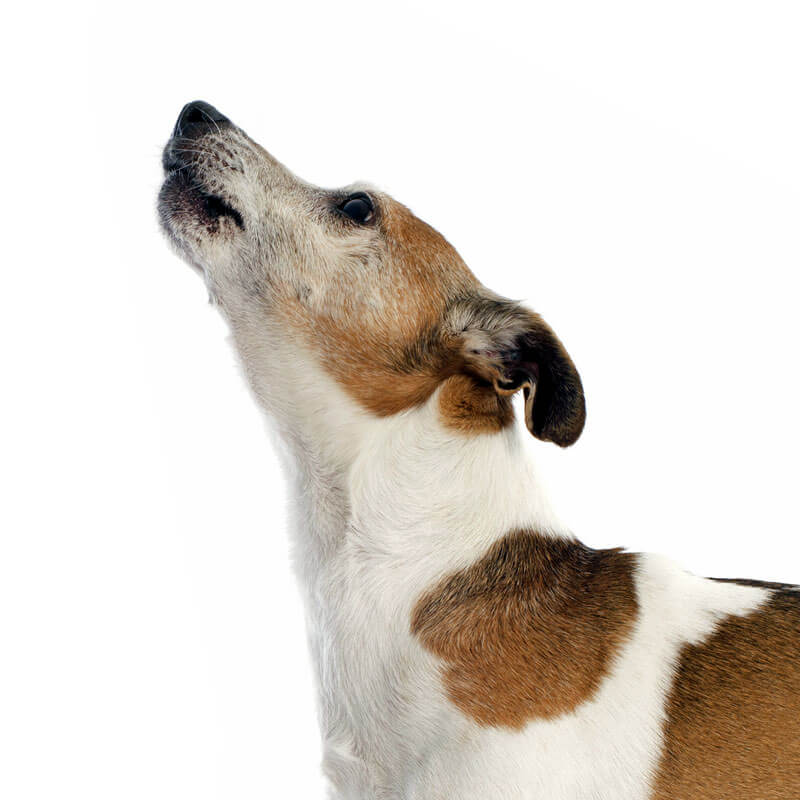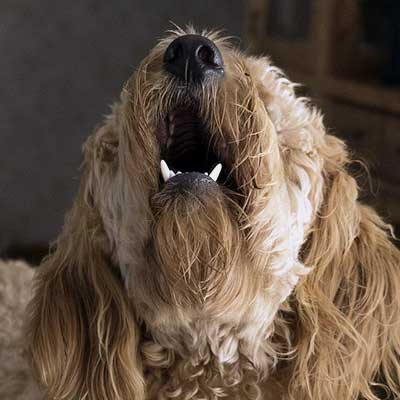
Dogs communicate by barking. Barking is normal behavior for dogs to exhibit in a variety of situations, e.g. someone is at the door, play barks when socializing with his pals, playing with you, etc. In general, most people want a dog who alerts them that someone is at the door or something is amiss. At the same time barking can escalate and quickly become out of control.
Problematic Barking
- Because of various environments, improper management or owners inadvertently encouraging barking, dogs often develop barking behaviors that range from being a nuisance to excessive. Additionally, excessive barking usually results in upset neighbors, nuisance complaints and citations not to mention driving a dog owner crazy from the barking.
- Dogs often bark because they want our attention. If we give them our attention for barking, then we are training them to bark more in the future. If we put our dog outside and the dog barks and we bring it back in what have we taught it? That’s right, barking — and that barking is rewarded. Very often, without realizing it, we, as dog owners, do things with our dogs with the best of intentions which make problems worse instead of better.
Solving Barking Problems – Some Dos and Don’ts
It is our experience that your dog’s barking problem may be resolved by an owner becoming educated. We like Dr. Ian Dun-bar’s approach to first reduce the frequency of barking before we all go insane; and second, teach your dog to “Woof” and “Shush” on cue. At first, it may crazy to teach your dog to bark on command — bark even more? By teaching a dog to bark or shush (quiet) on command your dog will better understand when barking is allowed (and when it’s not).
Reduce the Frequency of Barks
- Dogs often bark due to boredom, loneliness and separation anxiety. Additionally, dogs bark usually right after their owners leave home for the day. The easiest way to immediately reduce your dog’s bark-frequency is by exclusively feed-ing your dog from filled chew toys. (Click here for our chew toy stuffing recipe). When you are at home, practice by giving your dog some frozen stuffed chew toys and walk in and out of the room, the house, and eventually leave the house for a few minutes. Build up the duration of your departure. It is our experience that your dog will spend lots of time busily extricating his treats from the chew toys. And if your dog is entertaining himself with chew toys, he will be lying down quietly and most likely not barking.
- It is not recommended to leave an excessive barker outdoors. Yard-bound dogs are exposed to many distractions and are more likely to bark because of them or become boredom barkers. Leave your dog comfortably in a single room (away from the street) with a radio playing to mask outside disturbances. If you have been leaving your dog outside because he soils or destroys the house, housetrain and chew toy train your dog so he may enjoy indoor comforts when you are away from home.
- Additionally, when a dog barks do not say “it’s okay, it’s okay” and/or pet your dog while barking. This only reinforces your dog to bark.
Teach “Woof” and “Shush” On Cue
(by Dr. Ian Dunbar)
It is easier to teach your dog to shush when he is calm and focused. Therefore, teaching your dog to “Woof” on cue is the first step in “Shush” training, thus enabling you to teach “Shush” at your convenience, and not at inconvenient times when the dog decides to bark. Moreover, teaching “Shush” is now much easier because your dog is not barking uncontrollably — barking was your idea!
- Station an accomplice outside the front door. Say “Woof” (or “Speak,” or “Alert”), which is the cue for your assistant to ring the bell. Praise your dog profusely when he barks (prompted by the doorbell); maybe even bark along with your dog. After a few good woofs, say “Shush” and then waggle a tasty food treat in front of his nose. Your dog will stop barking as soon as he sniffs the treat because it is impossible to sniff and woof simultaneously. Praise your dog as he sniffs quietly, and then offer the treat.
- Repeat this routine a dozen or so times and your dog will learn to anticipate the doorbell ringing whenever you ask him to speak. Eventually, your dog will bark after your request but before the doorbell rings, meaning that your dog has learned to bark on command. Similarly, your dog will learn to anticipate the likelihood of sniffables following your “Shush” request. You have then taught your dog both to speak and shush on cue.
- Over repeated “Woof” and “Shush” trials, progressively increase the length of required shush-time before offering a food reward — at first just two seconds, then three, then five, eight, twelve, twenty, and so on. By alternating instructions to woof and shush, the dog is praised and rewarded for barking on request and for shushing on request.
- Remember, always speak softly when instructing your dog to shush, and reinforce your dog’s silence with whisper-praise. The more softly you speak, the more your dog will be inclined to pay attention and listen (and therefore, not bark).
Teach Your Dog When to Bark
- Practice makes perfect. We recommend practicing this exercise starting with 1-2 people coming to the door then building up to more visitors as your dog learns to bark and shush. Invite a few people for a couple of hours to help teach your dog when, and when not, to bark. Before people arrive put your dog on 4-6 foot nylon or leather leash (no retractables) and have him perform basic commands, rewarding him with treats he likes.
- When people arrive, Instruct your visitors (some with dogs) to walk by the house a number of times before ringing the doorbell. When the first person walks by the house, it will take all of your attention to keep your dog shushed. Ask your dog to look at you and sit. And, persevere: it will be easier when the same person walks by the second time, and again easier on the third pass by.
- Eventually, your dog will settle down and will no longer alert to the same person’s presence in the street. Lavish your dog with praise and offer treats for the silent treatment. Repeat reinforcement for quiet vigilance several times on subsequent passes by. When your visitor starts to walk up to the door, eagerly and urgently say to your dog”Speak! Speak! Speak!” Praise your dog when he barks, and then instruct him to sit and shush at the front door while you welcome the visitor. Do not let anyone pet the dog (including yourself) until the dog is quiet and all his four paws are on the ground.
- If your dog exuberantly barks and bounces at this point, simply wait until he sits and shushes and then praise and offer a treat. Have the visitor leave and come back a number of times. Eventually, your dog will greet him by sitting in silence. This process becomes easier with each new visitor. Your dog soon learns to watch passersby in silence and to bark when they step on your property, but to sit and shush when they are invited indoors.
- Followup by asking people to come to your door for schedule visits – short, frequent visits (even a couple times a day in the beginning) will help your dog understand that visitors are welcomed and that there is a procedure for you and your dog when visitors come to the door.
- You and your invited guests have to be able to enter your home without major drama ensuing each and every time without your dog ‘losing’ it and testing the patience of everyone. By teaching your dog to be calm when people arrive you are also reducing his stress level.

Additional Tips
- No long goodbyes! When you overdo goodbyes and overdo returns, what you are telling your dog is that your absence is a major event – and this often encourages your dog to bark more while you’re gone.
- Provide your dog a chew toy to distract her or him and then when the dog is concentrating on the toy then — without saying a word — leave the room and close the door. A few minutes later, reenter the room but don’t pet your dog or even make eye contact no matter how much your dog greets you. The point you are making with your dog is that comings and goings are perfectly normal.
- When it comes time for you to leave for the day, do not say goodbye to your dog. We recommend giving your dog a chew toy and when it is not paying attention to you quietly slip out the door.
- When you return home you stay calm and don’t greet your pup just yet. Wait until your dog calms down and then tell him or her to sit. Once the dog sits then a simple head pat and a “good dog” is acceptable. When you are ready and your dog is calm playing fetch, tug or going for a walk is a great outlet for you and your dog (provided he is calm).
Where to Find Help
Barking is natural for dogs but can quickly get out of hand. Call or email us today to discuss dogs’ with a barking problem and how to resolve it.



